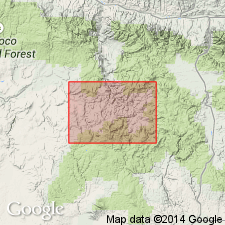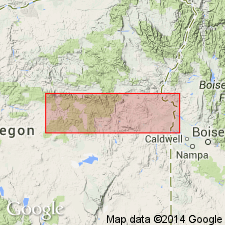
- Usage in publication:
-
- Silvies Member
- Modifications:
-
- Original reference
- Dominant lithology:
-
- Volcaniclastics
- AAPG geologic province:
-
- Snake River basin
Summary:
Pg. 49-51, pls. 1, 3. Silvies Member of Snowshoe Formation. A thick lens of volcaniclastic strata characterized by abundant intercalations of andesitic sandstone and conglomerate. Between the graywacke and conglomerate sequences, which individually attain thicknesses in excess of 100 feet, are sequences of laminated volcaniclastic siltstone similar to strata of unnamed middle member in type locality of the Snowshoe. At type locality about 1,500 feet of strata are exposed within the member; upper and lower contacts placed at highest and lowest ledges of massive andesitic sandstone or conglomerate. Extent of member to east not known; to west grades laterally by intertonguing to finer grained volcaniclastic strata comprising middle member of type Snowshoe. Age is Middle Jurassic.
Type locality: embraces four quarter-sections surrounding juncture of secs. 21, 22, 27, and 28, T. 16 S., R. 27 E., where Silvies River and a small tributary from west have cut steep-sided well-exposed canyons across strike of unit, east-central OR.
Source: US geologic names lexicon (USGS Bull. 1350, p. 695).

- Usage in publication:
-
- Silvies Member
- Modifications:
-
- Overview
- AAPG geologic province:
-
- Snake River basin
Summary:
Pg. 48. Silvies Member of Snowshoe Formation defined by Dickinson and Vigrass (1965); characteristically exposed in canyon of upper Silvies Creek at juncture of secs. 21, 22, 27, and 28, T. 16 S., R. 29 E. Extensively exposed, in northeast-trending direction, in southeast part of Suplee-Izee district. To the west, grades into middle part of type Snowshoe. To the east, extent is undefined; Dickinson and Vigrass (1965) suggest possible equivalence to flows and breccias exposed south of Seneca. Silvies Member consists of 1,500 feet of volcaniclastic strata; contains abundant blue, hard, coarse-grained andesitic sandstone and conglomerate. Sandstone interbeds are graded, vary in thickness from 1 to 12 feet, and alternate with finer grained interbeds of siltstone and mudstone. The lutites are very similar to middle part of Snowshoe Formation of Lupher (1941) to the west. Silvies Member differs from equivalent Basey Member by presence of conglomerate, the prevailence of graded bedding, and several other more subtle features of texture and composition. Is conformable with overlying and underlying parts of Snowshoe. Facies relationships suggest derivation from volcanic pile located 25 miles east of Izee, beyond Seneca. To the west, infrequent graded beds in middle Snowshoe mark distal ends of turbidity current deposits in the Izee basin. Age is Middle Jurassic (middle Bajocian).
See also Dickinson, W.R., and Vigrass, L.W., 1965, "Geology of the Suplee-Izee area, Cook, Grant, and Harney Counties, Oregon," Oregon Dept. Geol. and Min. Ind. Bull., no. 58, 109 p., geol. map (scale 1:42,000).
Source: Publication.

- Usage in publication:
-
- Silvies Member*
- Modifications:
-
- Biostratigraphic dating
- Adopted
- AAPG geologic province:
-
- Snake River basin
Summary:
Silvies Member of Snowshoe Formation. Silvies Member of Dickinson and Vigrass (1965) is adopted by the USGS as 1 of 4 members of Snowshoe Formation in Izee area, eastern Oregon. Intertongues with unnamed middle member; overlies and underlies unnamed lower and upper members, respectively. Age is Middle Jurassic. Report includes detailed faunal lists, descriptions, map locations of Bajocian ammonites.
Source: Changes in stratigraphic nomenclature, 1973 (USGS Bull. 1395-A, p. A38-A39); supplemental information from GNU records (USGS DDS-6; Menlo GNULEX, Warm Springs entry).
For more information, please contact Nancy Stamm, Geologic Names Committee Secretary.
Asterisk (*) indicates published by U.S. Geological Survey authors.
"No current usage" (†) implies that a name has been abandoned or has fallen into disuse. Former usage and, if known, replacement name given in parentheses ( ).
Slash (/) indicates name conflicts with nomenclatural guidelines (CSN, 1933; ACSN, 1961, 1970; NACSN, 1983, 2005, 2021). May be explained within brackets ([ ]).

